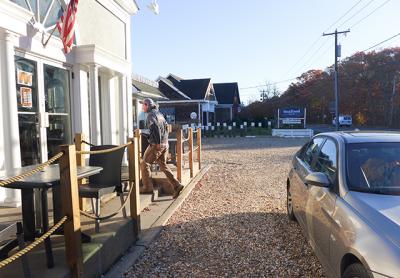Town Ready to Enact Wainscott Moratorium

A one-year moratorium on development in Wainscott is expected to be approved by the East Hampton Town Board, perhaps as early as at a meeting tonight, after an initial vote was delayed at the request of Councilman Fred Overton to make time for further discussion.
The moratorium, on properties in Wainscott zoned for central business or commercial-industrial uses and land in residential zones being used for nonresidential purposes, would ban approval of new construction or expansions of more than 25 percent of existing buildings that increase legal occupancy.
The affected area, generally along the Montauk Highway, is bordered by the Long Island Rail Road tracks to the north, Town Line Road at the west, and Hedges Lane and the East Hampton Village boundary to the east.
Subdivisions and site plans on which the planning board already has held a public hearing and issued approvals would be allowed to proceed, and exemptions could be applied for.
Mr. Overton had expressed concern that the moratorium was a response to community objections to a proposal under review by the planning board for a car wash at the former Star Room nightclub. He said he shared the opinion that the site was not a good one for a car wash. “However, there is due process; there are property rights,” he said. He also expressed concern about using a building halt as a way to address traffic through Wainscott, which, he said, “is never going to go away.”
“It’s absolutely about the car wash,” Town Supervisor Larry Cantwell said at the board’s meeting on Tuesday, “but it’s equally about every other commercial development that could happen in that corridor.” Traffic issues cannot be eliminated, he said, but potential future development could make them worse.
The moratorium was proposed to stave off major changes while consultants engaged by the town to come up with individual plans for the hamlets compile their recommendations, and to give town officials time to adopt zoning and other laws that could shape the future of the hamlets.
The concept of a “walkable hamlet,” a center that, like those in other East Hampton areas, would feel more like a downtown instead of just a strip along Montauk Highway, was brought up and endorsed by the residents who participated in a planning session, or charette, earlier this year with the consultants.
“We had a very good turnout at the charette,” Marguerite Wolffsohn, the town planning director, reminded the board at the meeting. Using a 3-D model, the participants “basically designed a future Wainscott.”
“The moratorium puts a freeze on things so there won’t be any further redevelopment that is inconsistent with that vision,” Councilman Peter Van Scoyoc said.
An Oct. 6 hearing on the moratorium drew largely positive comments, save for one on behalf of the East Hampton Business Alliance. Ms. Wolffsohn, however, said this week that proprietors of Wainscott businesses were among those endorsing the moratorium, and had indicated they were on board at a special presentation on the future plans for the hamlet.
The Suffolk County Planning Commission approved the proposed moratorium on Nov. 2 by a 9-to-4 vote.
“This seems like a reasonable plan. I’m not passionately against this,” Mr. Overton said. But, he said, he would like assurances that the planning and policy-making process would continue apace so that lengthy extensions of the moratorium would not be needed.
The period of one year for the Wainscott moratorium was chosen to allow time for the consultants to finish their study and for town officials to act on the recommendations, Ms. Wolffsohn said.
